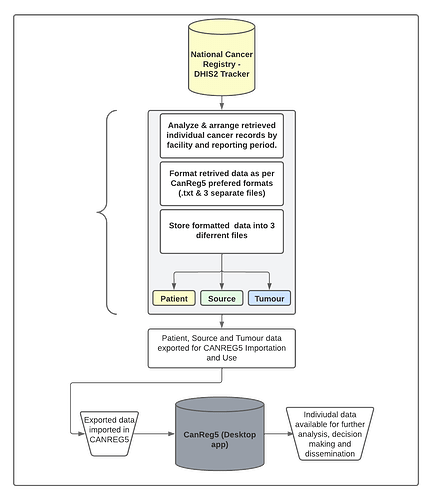Background
In Rwanda, the Ministry of Health/Rwanda Biomedical Center integrated CanReg5 and DHIS2 to implement a robust digital cancer registry and analytics system. Before the implementation, cancer data in the country were collected on paper forms and MS Excel, then manually transcribed into an offline stand-alone application called CanReg5 for analytics. This caused data quality issues including data losses, and delayed reporting, among other challenges. Typically, CanReg5 and DHIS2 had no default mode for data sharing, hence, HISP Rwanda developed a custom application that facilitates data translation from DHIS2 Tracker in which data are collected from health facilities, into CanReg5 for analysis. The preliminary analysis takes place in DHIS2 but CanReg5, which was developed in accordance with the International Association of Cancer Registers handles the more complex analysis.
Before the implementation of the integrated CanReg5 and DHIS2 system, cancer data in Rwanda was collected on paper forms and MS Excel, then manually transcribed into an offline stand-alone application called CanReg5 for analytics. This process often resulted in data quality issues such as data losses, delayed reporting, and errors in data transcription. Additionally, the data collected lacked standardization and completeness, making it difficult to develop comprehensive cancer control strategies.
CanReg5 and DHIS2 Integration
CanReg5 is an open-source software developed by the International Agency for Research on Cancer (IARC) to facilitate the management of cancer registry data. DHIS2 is a widely used health information system for collecting and analyzing health data. Typically, CanReg5 and DHIS2 had no default mode for data sharing. Therefore, HISP Rwanda developed a custom application that facilitates data translation from DHIS2 Tracker, in which data is collected from health facilities using DHIS2 Tracker, then imported into CanReg5 for analysis.
The integration of CanReg5 and DHIS2 has streamlined data management processes, improved data quality, and minimized errors. The preliminary analysis takes place in DHIS2, which is used to generate basic reports on cancer data. CanReg5 contains more advanced tools for cancer analytics, such as the calculation of incidence rates and age-specific rates. CanReg5 also provides comprehensive data quality checks, data standardization, and completeness checks.
Implementation and Impacts: The implementation of the integrated CanReg5 and DHIS2 system involved various organizations and stakeholders, including the Ministry of Health, the International Agency for Research on Cancer, and HISP Rwanda. The Ministry of Health led the implementation, while the International Agency for Research on Cancer provided technical expertise and support. HISP Rwanda developed a custom application that facilitates data translation from DHIS2 Tracker to CanReg5.
Below is a simplified integration architecture between the National DHIS2 Cancer Registry system and CANREG5;
The integrated system has had significant impacts on cancer data management in Rwanda. The system has improved data quality and completeness, enabling the development of more comprehensive cancer control strategies. The system has also reduced delays in reporting, providing timely information for decision-making. The system has facilitated the tracking of cancer patients across the continuum of care, including diagnosis, treatment, and follow-up. The system has also enabled the measurement of progress toward national and global cancer control targets. The implementation of this digital solution is a significant step towards achieving Rwanda’s goal of reducing cancer incidence and mortality.
Challenges/Lessons Learned
- There are other systems used in health facilities, requiring new data entry into DHIS2 as they are not all interoperable.
- The system requires regular data quality checks by cancer registrars at the National level
Next Steps
- Integration with other systems is ongoing to have a complete Cancer registry. ( Those systems are EMRs at health facilities, CRVS, and verbal autopsy.
- Update the DHIS2 Canreg app to make it more dynamic by improving on validation and outputs
- Packaging of DHIS2 Cancer registry with partners
